I grew loads of peppers in my garden this year just so I could make this fermented hot sauce recipe. It is wonderfully spicy and big on flavor. Drizzle it over anything. Works for any type of peppers.
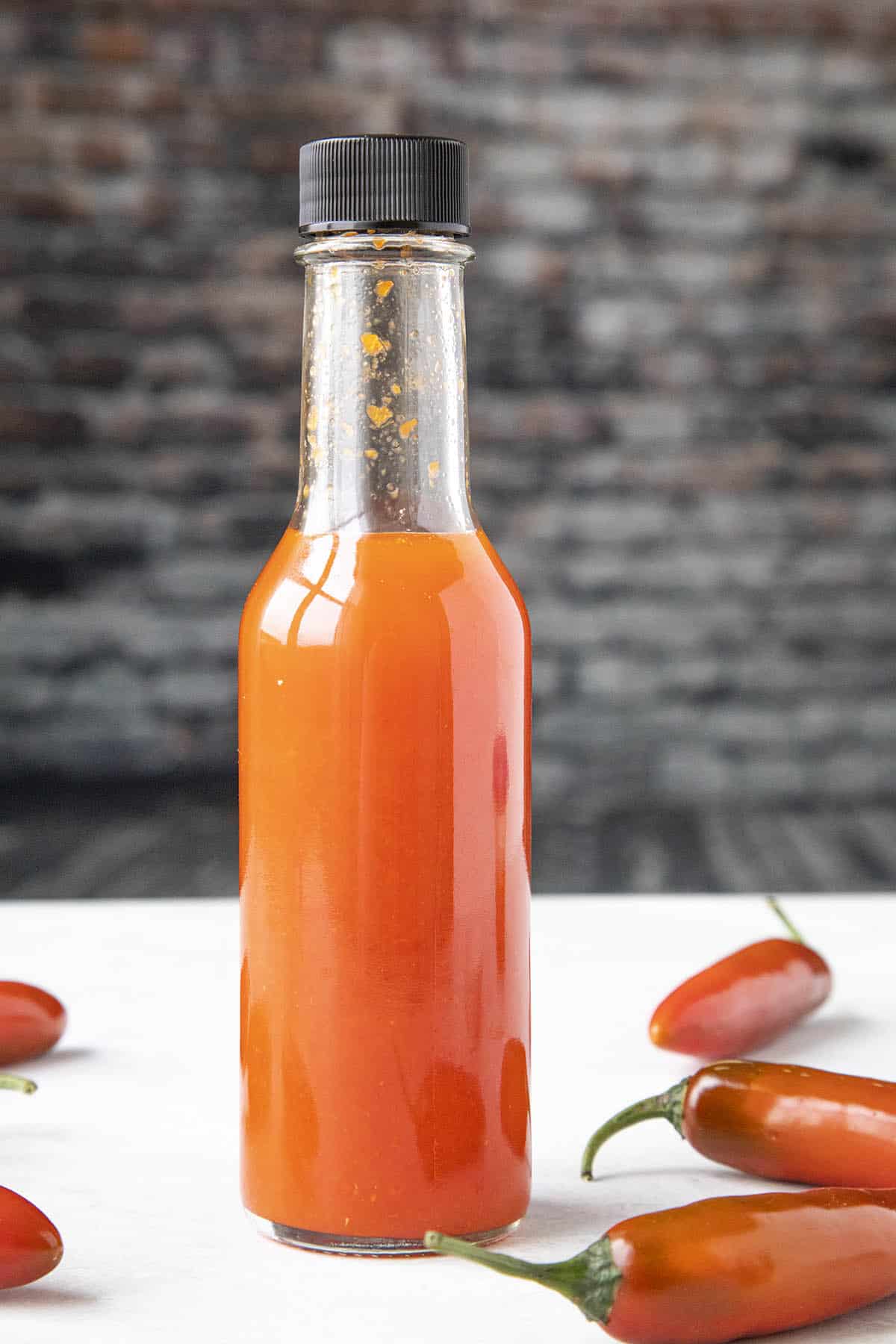
Fermented Hot Sauce Recipe
It's hot sauce making time in the Chili Pepper Madness household again, my friends. You know how much I LOVE my hot sauce. My garden exploded with peppers this year and I'm incredibly happy.
The plants were super productive and I am preserving them in so many different ways.
Food preservation is important. One of my favorite ways to preserve my peppers is to make hot sauce. I have a LOT of different hot sauce recipes here on the site, all with different styles, ingredients, and types of chili peppers.
For this particular hot sauce, I wanted a fermented version, which adds another layer of complexity to the sauce.
I grew serrano peppers and waited for them to turn red specifically so I could make this sauce. So many serranos! The plant was very productive.
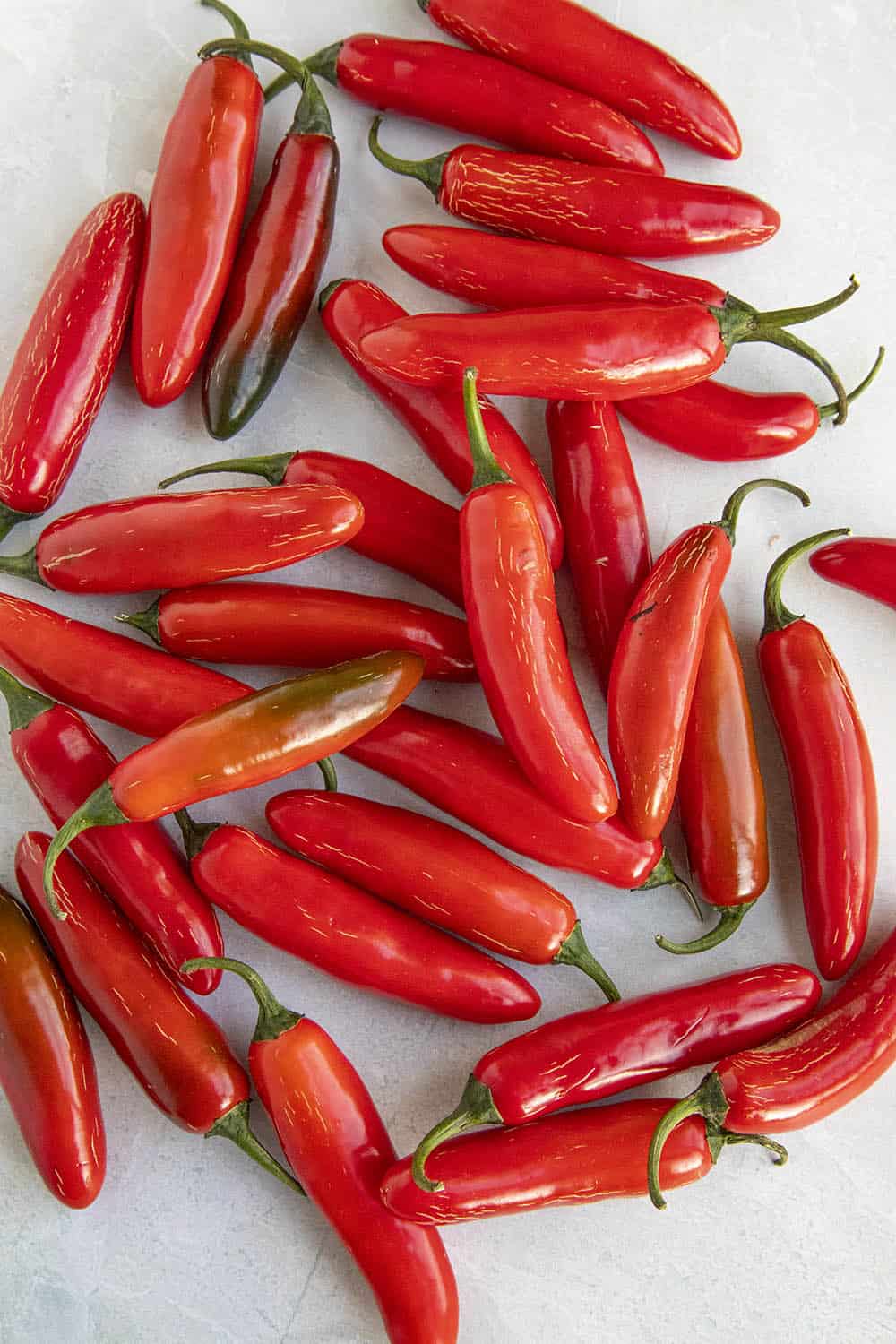
I just love serrano peppers. They're smaller than jalapeno peppers, but quite a bit hotter. In fact, the hottest serrano pepper is about 3 times hotter than the hottest jalapeno pepper.
They measure in at 10,000 to 23,000 Scoville Heat Units on the Scoville Scale. For me, that's a nice level of heat for an every day hot sauce.
You don't have to use serranos, though. This recipe works with any type of chili pepper.
This is a very simple hot sauce recipe, though we're fermenting the peppers first, which may sound complicated, but not at all.

What is Fermentation? And Why is it Good For Hot Sauce?
Fermentation is the decomposition of foods by micro-organisms (Lactic Acid Bacteria) or enzymes. We create an anaerobic (no oxygen) environment for the peppers so that good, beneficial bacteria can survive, and bad bacteria cannot survive.
The good bacteria is natural Lactic acid bacteria, which consumes carbohydrates in the peppers and converts them to acid. After fermenting, the carbohydrates have been predigested, leaving them with more vitamins and flavor than fresh peppers.
Bad bacteria, such as rotting molds, cannot survive in this oxygen-free environment. We create such an environment with salt and brine, which protect the peppers while the good bacteria do their work.
The salt is not actually the preservative. It is the acid produced by the fermentation process that does the preserving.
There are many benefits to fermented foods, including foods that are more digestible and have more developed flavor. When fermenting peppers, the flavors mellow, and peppers change color a bit, and develop a pleasant smell.
Fermentation is one our oldest methods of food preservation. People have preserved foods this way for generations, from wine to cheese to many, many vegetables, including peppers.
Let's talk about how to make a simple fermented hot sauce, shall we? Here is my recipe for fermented hot sauce.
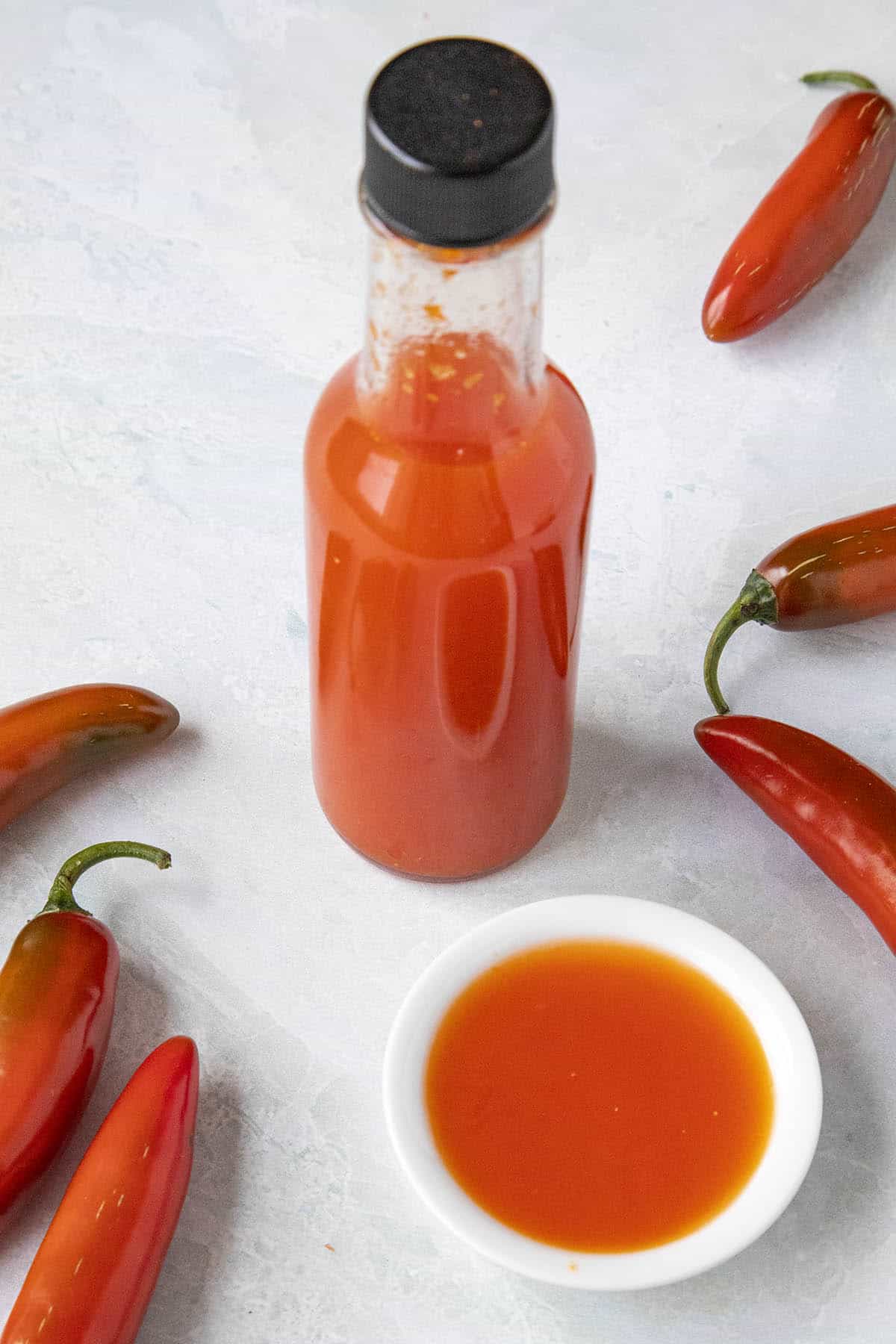
Ingredients Needed to Make Fermented Hot Sauce
- 1 pound chili peppers (stems removed - I'm using red serrano peppers)
- 1 quart unchlorinated water
- 3 tablespoons salt
- ½-1 cup white wine vinegar to your preference (use a good quality vinegar for better quality hot sauce)
How to Make Fermented Hot Sauce - the Recipe Method
First, ferment the chili peppers. Roughly chop the peppers, then pack them into a ball jar, leaving at least 1 inch of head space. The peppers may rise a bit when fermenting.
Mason jars are good to use as fermentation vessels as well.

Make the Brine. Next, mix 1 quart unchlorinated water with 3 tablespoons sea salt. Pour just enough brine over the peppers to cover them, pressing them down a bit as you go.
It is important to keep the peppers covered with the salt water brine to avoid spoilage. Check this daily.
HELPFUL TIP: A good method to keep the peppers submerged is to fill a baggie with some water, but not all the way. Stuff the baggie into the top of the jar, forcing the peppers down below the brine.
Screw on the lid and set the jar away from direct sunlight to ferment for at least 1 week. Ideal temperatures are between 55-75 degrees F.
The most active fermentation period is between 1-2 weeks, so be sure to monitor it during this time. “Burp” the jars often by unscrewing the lid a bit to let out some of the accumulating gases.
Or, use an airlock or membrane for easier fermenting. See our page, “How to Ferment Peppers”, for more detailed instruction.
After 1-2 weeks, the fermenting activity will diminish and the brine will turn cloudy and taste acidic, with a slightly sour flavor.
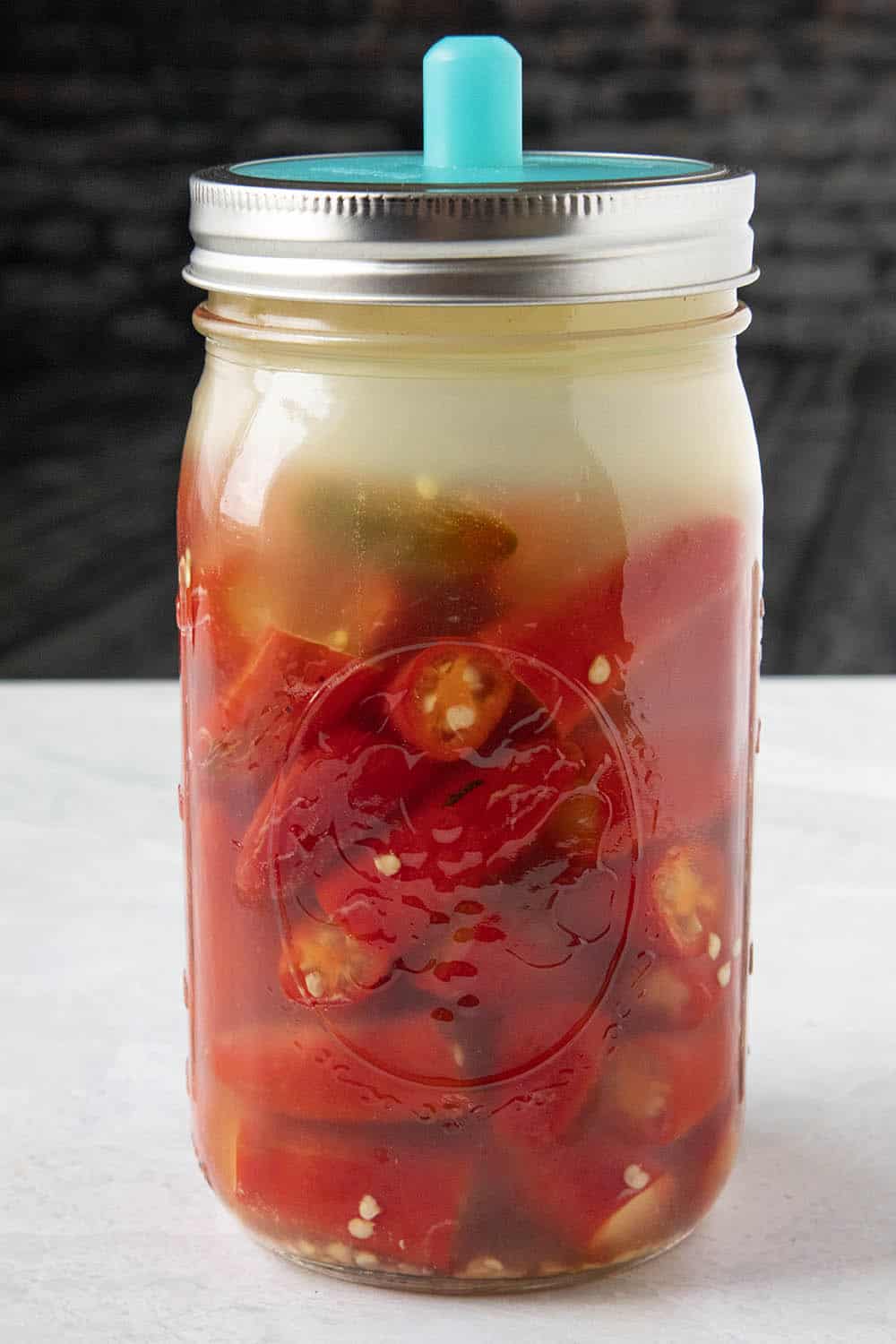
Drain the peppers, but reserve the brine.

Add the fermented peppers to a food processor or blender, along with 1/2 cup of the brine and 1/2 cup vinegar.
You can add more or less of each as desired to your preference. More brine will have more salty flavor, more vinegar will be more acidic.
Blend until smooth.
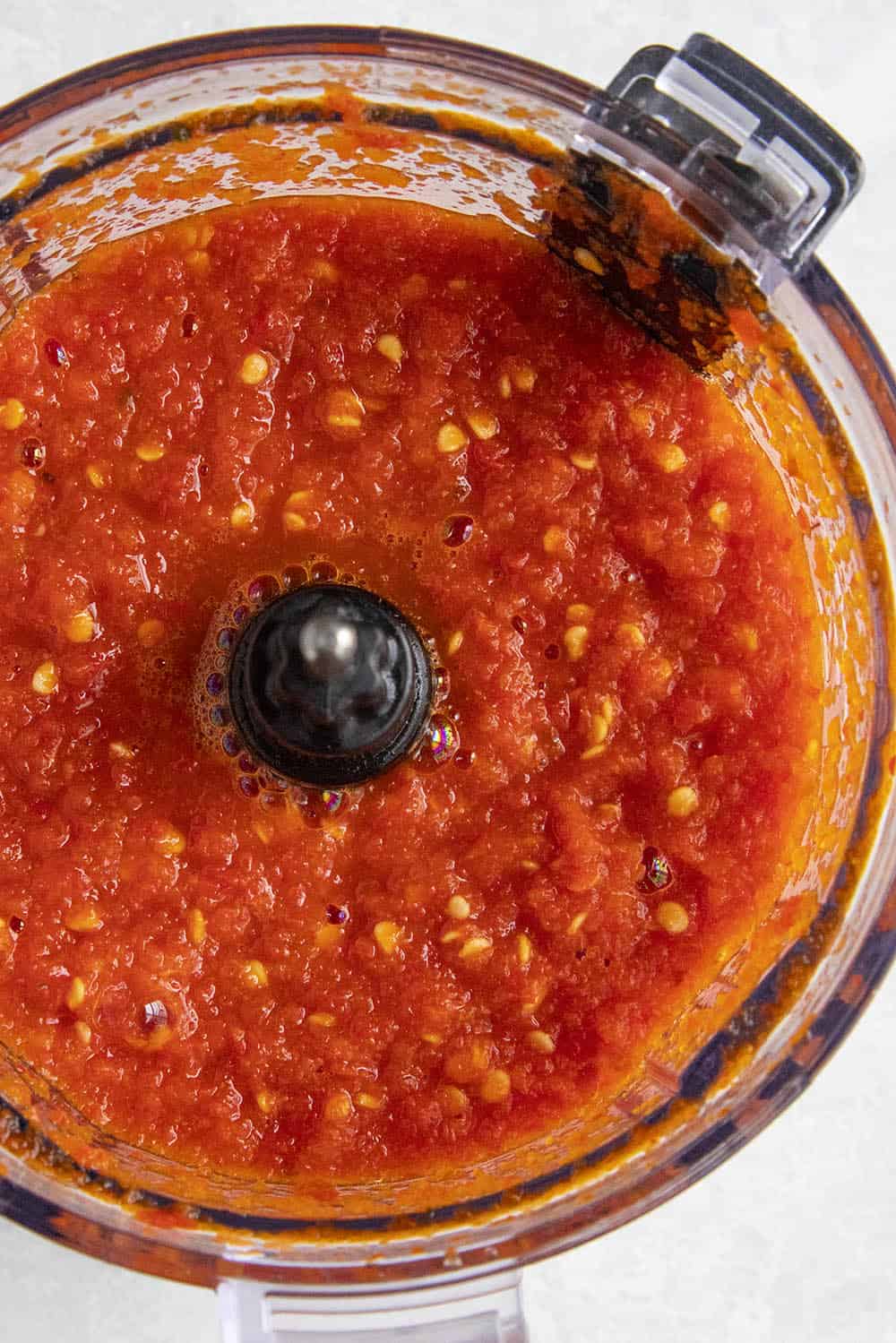
OPTIONAL: Add the fermented hot sauce to a pot and bring to a quick boil. Reduce heat and simmer for 15 minutes. This will stop the fermentation process.
NOTE: You don't have to cook the sauce if you don't want to. Cooking removed the probiotic benefits. It can be used as-is, though you will likely see some continued fermenting activity. If you decide to not cook it, store it in the refrigerator in sealed containers.
You may need to burp them to release gas buildup every now and then, though refrigeration will slow the activity.
Strain the mixture to remove the solids if desired, or use as-is for a thicker hot sauce. Pour into hot sauce bottles and enjoy.
That's it, my friends! Easy, right? Who knew making a fermented hot sauce could be so simple? It's really quite a bit like famous Tabasco Hot Sauce, though made with red serrano peppers instead of tabasco peppers.
Recipe Tips & Notes
Fermentation Time. Feel free to ferment longer if you'd like. Continuing to ferment the peppers will develop even more flavor. I have fermented peppers for 6 months in the past.
Some people ferment for years. 1 week, however, is enough to get a good ferment.
Kahm Yeast. Sometimes you may notice a white film forming on the top of your ferment. It is sour and can form when all of the sugar in your ferment is consumed.
It is not a mold, nor is it harmful. It can affect the flavor of your finished hot sauce, so it is best to be scraped away from your ferment.
Thicker or Thinner Hot Sauce. If you're looking for a thicker hot sauce, only use a combined half cup of brine and vinegar, and do not strain the hot sauce.
For a thinner hot sauce, add more water and/or vinegar a bit at a time until you achieve the consistency you want.
Straining the hot sauce will thin it out considerably.
Other Ingredients. This is a very simple Louisiana Style Hot Sauce recipe, using only peppers, vinegar and salt.
You can easily include other ingredients to build flavor, such as garlic, onion, herbs and other seasonings.
Other Peppers. This method works with any type of chili peppers. Try it with a blend of hot peppers and/or mild peppers.
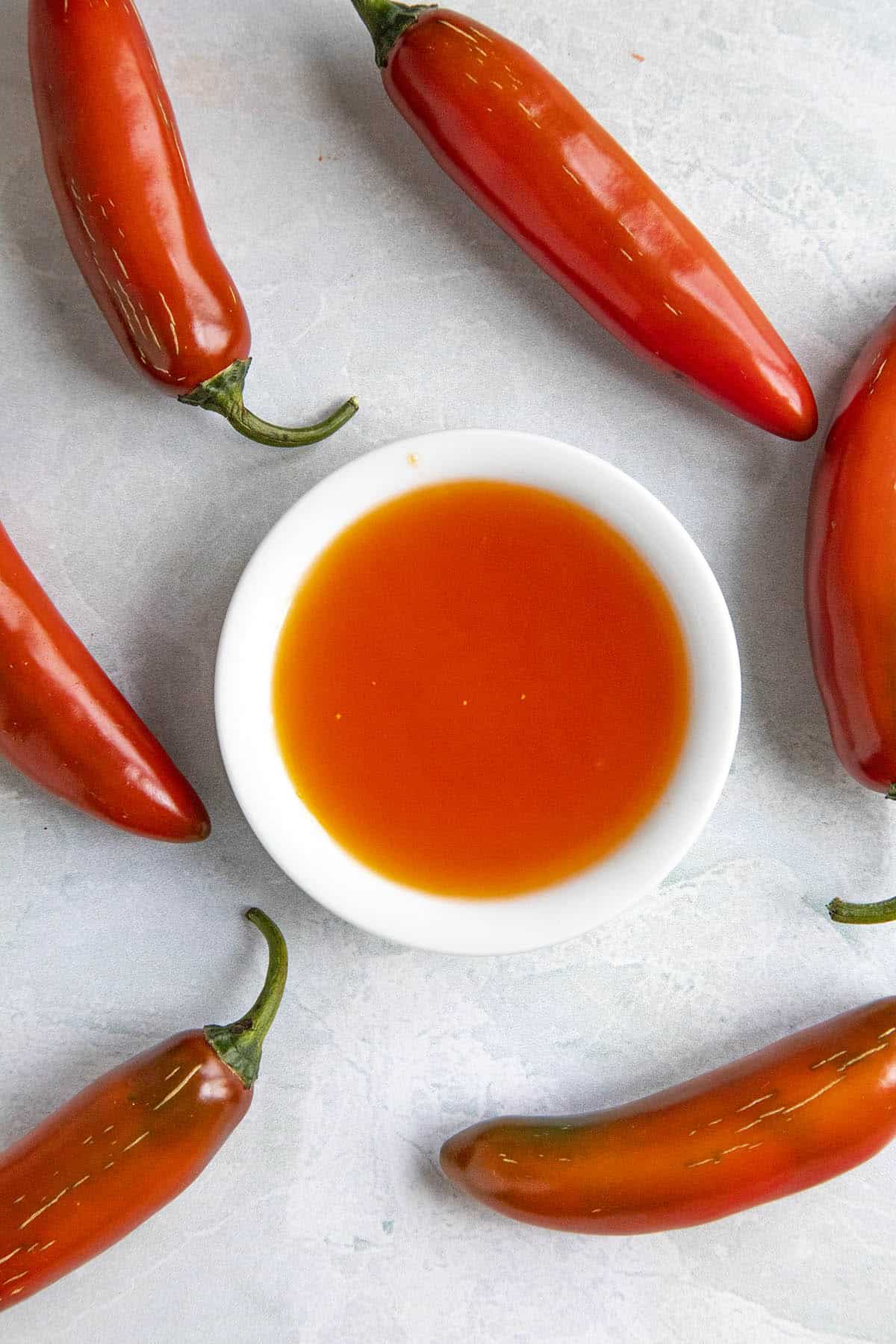
Frequently Asked Hot Sauce Questions
Here are answers to some of the most common questions I get on other hot sauces.
How long will this sauce keep?
Fermented hot sauce will keep for many months in the refrigerator, or even longer. It's all about the acidity.
To be technical, target level ph for shelf stable foods is below 4.6 ph, but should probably be lower for home cooks, around 3.5 or so, to account for errors.
If you're concerned, add more vinegar to lower the ph. I measured the pH of my finished fermented hot sauce at 3.7, but check with a good pH meter.
The best ph meters that I recommend are from Thermoworks. Get yourself a ph meter from Thermoworks today. I am a happy affiliate.
Fermented hot sauces that are not cooked at the end with vinegar and/or citrus should be refrigerated.
Cooking them stops the fermentation activity and makes them more shelf stable, though they are no longer probiotic.
Where'd you get that sauce bottle?
I find them locally sometimes, but I also order through Amazon. Here is a link to some bottles I like (affiliate link, my friends!): Swing Top Glass Bottles, 8.5 Ounce - Set of 4.
If you like the smaller bottles that most hot sauce makers use, here's another link: Hot Sauce Bottles, 5 Oz - 24 Pack.
Can I process this hot sauce for longer storage?
Absolutely. Just be sure to use proper canning/jarring safety procedures. Processing the hot sauce in a water bath stops the bacterial activity, making the hot sauce shelf-stable.
However, it will no longer be probiotic. The National Center for Home Food Preservation provides home canning instructions and many recipes that have been tested for food safety. NCHFP.uga.edu.
Useful Equipment
Aside from jars and your ingredients, I like to use Masontops lids, which include pickling weights and a membrane allowing gases to escape without the need for burping.
You can use them with any wide mouth mason jar. Here is a link to where you can buy them on Amazon. It’s an affiliate link, my friends. FYI!
Buy Masontop Lids for Fermenting Chili Peppers (and More)
I also highly recommend this outstanding book by fermenting experts, Kirsten K. Shockey and Christopher Shockey – “Fiery Ferments: 70 Stimulating Recipes for Hot Sauces, Spicy Chutneys, Kimchis with Kick and Other Blazing Fermented Condiments”. I learned a lot from this book as well as through my own experimentation. Grab a copy today.
Good luck, and happy fermenting! Let me know what you make with your pepper mash.
Try Some of My Other Fermented Hot Sauce Recipes
Here are some of my own recipes that use fermented chili peppers.
- Homemade Sriracha Hot Sauce
- Fermented Aji-Garlic Hot Sauce
- Homemade Louisiana Hot Sauce
- Homemade Tabasco Sauce
- Spicy Serrano Hot Sauce
Check out more Hot Sauce Recipes or learn more about How to Make Hot Sauce.

Got any questions? Ask away! I’m happy to help. If you enjoy this recipe, I hope you’ll leave a comment with some STARS. Also, please share it on social media. Don’t forget to tag us at #ChiliPepperMadness. I’ll be sure to share! Thanks! — Mike H.
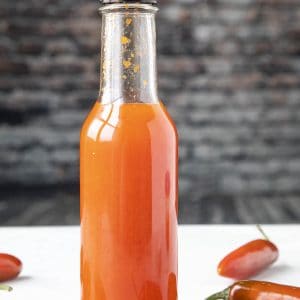
Fermented Hot Sauce Recipe
Ingredients
- 1 pound red serrano peppers or use any chili peppers, stems removed
- 1 quart unchlorinated water
- 3 tablespoons sea salt (do not use iodized salt)
- ½-1 cup white wine vinegar to your preference use a good quality vinegar for better quality hot sauce
Instructions
- First, ferment the serrano peppers. Roughly chop the peppers, then pack them into a ball jar, leaving at least 1 inch of head space. The peppers may rise a bit when fermenting.
- Next, mix 1 quart unchlorinated water with 3 tablespoons sea salt. Pour just enough brine over the peppers to cover them, pressing them down a bit as you go. It is important to keep the peppers covered with brine to avoid spoilage. Check this daily.
- Screw on the lid and set the jar away from direct sunlight to ferment for at least 1 week. Ideal temperatures are between 55-75 degrees F. The most active fermentation period is between 1-2 weeks, so be sure to monitor it during this time. “Burp” the jars often by unscrewing the lid a bit to let out some of the accumulating gases. Or, use an airlock or membrane for easier fermenting. See our page, “How to Ferment Peppers”, for more detailed instruction.
- After 1-2 weeks, the fermenting activity will diminish and the brine will turn cloudy and taste acidic.
- Drain the peppers, but reserve the brine.
- Add the fermented peppers to a food processor or blender, along with 1/2 cup of the brine and 1/2 cup vinegar. You can add more or less of each as desired to your preference. More brine will have more salty flavor, more vinegar will be more acidic.
- Process until smooth.
- Optional Step. Add the fermented hot sauce to a pot and bring to a quick boil. Reduce heat and simmer for 15 minutes. This will stop the fermentation process and meld the flavors, but will remove the probiotic benefits.
- Strain the mixture to remove the solids if desired, or use as-is for a thicker hot sauce. Pour into hot sauce bottles and enjoy.
- You can add more vinegar or water to thin out the hot sauce.
Notes
Nutrition Information


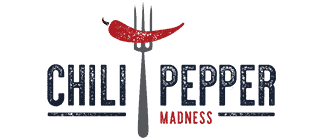


Vivian de Bloeme says
Easy and delicious! I used a combination of chilies from my tiny garden along with some onion and garlic, as suggested. Fermentation started in a few days and it looked done on day 8. So strained, added vinegar along with the brine, blended, then strained again. 5 1/2 little bottles. My condo smells amazing!
(Looking forward to your shipping your new book to Canada.)
Mike Hultquist says
Awesome!! Glad to help. Vivian! I hope you enjoy my new book!
Alex G McMullen says
Good evening - I did 2 different fermented hot sauces with ratio similar to what you described - jalapeno/tomatillo and scorpion peach. I'm using the burping lids and its been two months and no activity and crystal clear in the 1.5 litre mason jars. I noticed some bubbles early but nothing like pickles, sauerkraut etc. Is it just too salty? should I dump some and dilute it?
Mike Hultquist says
It's hard to say, Alex. There are quiet ferments that produce very little activity. But, it sounds like you may have too much salt, which can inhibit fermentation. Could be a good idea to make a new solution. Shoot for 3%.
Olive says
Mike, I want to try this but do all the peppers have to be red?
Mike Hultquist says
Olive, NO, you can ferment green peppers or peppers of any color, actually. Enjoy!
Larry Brooke says
Hey Mike
Thanks for allowing me to subscribe! Just made another batch of your Bajan hot sauce. Just like the Delish sauce I bring back from Barbados. Question - just started a batch of fermented peppers - can I use apple cider vinegar at the end or best to stick to regular?
Best regards
Mike Hultquist says
Thanks, Larry! You can use apple cider vinegar if you'd like - a little extra tangy flavor. It works great! Glad you're enjoying the recipes!
Kim says
Hi! I am fermenting peppers to make hot sauce. This is my first time making hot sauce. Can I add fresh ingredients like mango or carrot to the fermented hot sauce? How will this affect its expiration date? Sorry if this is a silly question. 🙂
Mike Hultquist says
Hi, Kim! Yes, you can ferment other vegetables with your peppers. It works great for extra funk factor and it does not affect anything, though if you ferment fruit, you often get more active fermentation. Be sure to burp often as needed. Enjoy!
Larry says
Hi. Just got done making this with jalapeno peppers. Fermented them for two weeks and processed them yesterday. When done I strained them thru a fine mesh strainer and bottled them. Today the sauce separated into two layers. I shake the bottles and it mixes back together. Is this normal? Thanks for the recipes I really enjoy your site!
Mike Hultquist says
Hi, Larry! Yep, perfectly normal to see separation with hot sauces. Giving it a good shake it all you need to bring it together again. Some people use thickeners, like xanthan gum, to help keep sauces from separating, but it's not really needed. Glad you're enjoying the site!! Thanks!